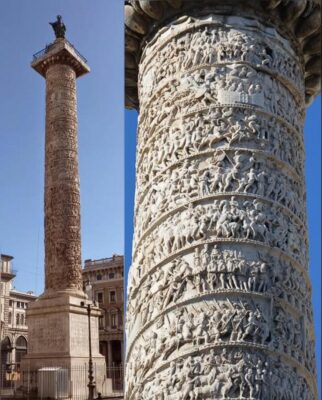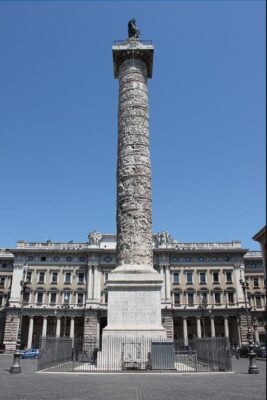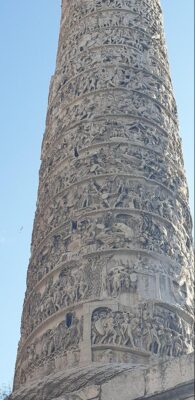The Column of Marcus Aurelius stands as one of Rome’s most remarkable historical landmarks. Built between 180 and 193 AD, it commemorates the emperor’s victories in the Marcomannic Wars, fought against the Germanic tribes and Sarmatians. Located in Piazza Colonna, this monumental structure not only reflects the military prowess of ancient Rome but also serves as a lasting tribute to the artistic and architectural achievements of the era.
The History and Purpose of the Column
The Marcomannic Wars and Marcus Aurelius’ Legacy
The Marcomannic Wars, which took place between 166 and 180 AD, were a series of intense conflicts between the Roman Empire and various Germanic and Sarmatian tribes. Emperor Marcus Aurelius, known for his philosophical wisdom and military leadership, led his forces to numerous victories, securing Rome’s northern borders. To commemorate these achievements, the column was erected in the heart of Rome, serving both as a celebration of conquest and a reminder of the emperor’s enduring influence.
Construction and Materials
The Column of Marcus Aurelius was constructed using Proconnesian marble, a high-quality material sourced from the island of Proconnesus (modern-day Marmara Island, Turkey). The column stands at approximately 39 meters (about 128 feet) in height, including its base and the statue that once crowned it. The design closely follows the earlier Trajan’s Column, reflecting Rome’s tradition of honoring military triumphs through monumental architecture.

The Column’s Location in Piazza Colonna
Situated in Piazza Colonna, the column remains in its original location, unlike many other ancient structures that were relocated or reconstructed over time. Piazza Colonna, a historic square in Rome, has long been a hub of political and cultural significance, making it a fitting home for such a monumental piece of Roman history.
Artistic and Architectural Significance
The Spiral Relief and Narrative Scenes
One of the most striking features of the Column of Marcus Aurelius is its intricate spiral relief, which wraps around the shaft in a continuous frieze. The relief depicts dramatic battle scenes, portraying Roman soldiers in combat, strategic maneuvers, and the emperor addressing his troops. This visual storytelling method allowed Romans of the time, many of whom were illiterate, to understand the grandeur of the emperor’s military campaigns.
The Rain Miracle: A Divine Intervention
Among the most famous scenes on the column is the depiction of the “Rain Miracle,” a legendary event in which a sudden thunderstorm allegedly saved the Roman army from certain defeat. According to historical accounts, during a battle against the Quadi tribe, the Romans were encircled and suffering from extreme heat and dehydration. Miraculously, a rainstorm erupted, providing water for the soldiers while unleashing lightning upon their enemies. This event was interpreted as divine favor, reinforcing the idea of Marcus Aurelius’ connection to the gods.

The Influence of Trajan’s Column
The Column of Marcus Aurelius was clearly inspired by the earlier Trajan’s Column, which was built in 113 AD to celebrate Emperor Trajan’s victories in the Dacian Wars. While both columns share a similar design, the Marcus Aurelius column features deeper carvings and a more dramatic style, possibly influenced by evolving artistic preferences in the later Roman Empire.
The Column’s Transformation Over Time
The Loss of the Original Statue
Originally, the column was topped with a bronze statue of Marcus Aurelius, reinforcing his status as a revered leader. However, the original statue was lost, and in the 16th century, Pope Sixtus V ordered its replacement with a statue of St. Paul, reflecting the shift from pagan traditions to Christian influence in Rome.
Preservation Efforts and Restoration
Despite centuries of exposure to natural elements and human activity, the Column of Marcus Aurelius remains remarkably well-preserved. Over the years, various restoration efforts have been undertaken to maintain its structural integrity and artistic details. Modern conservation techniques continue to protect this invaluable piece of Roman heritage.
The Column’s Role in Modern Rome
Today, the column stands as a prominent historical and tourist attraction, drawing visitors from around the world. Its presence in Piazza Colonna serves as a reminder of Rome’s imperial past, allowing both scholars and tourists to appreciate the grandeur of ancient Roman artistry and engineering.

Conclusion
The Column of Marcus Aurelius is more than just a towering monument; it is a historical narrative carved in stone, telling the story of Rome’s military triumphs, divine interventions, and artistic evolution. As one of the few ancient structures that remain in their original location, it offers a direct link to the past, allowing us to glimpse the grandeur of an empire that once ruled the world. Whether admired for its artistic beauty, historical significance, or architectural brilliance, this column stands as a testament to the enduring legacy of Marcus Aurelius and the Roman Empire.

CÁC TIN KHÁC
Mary Walton: The Forgotten Inventor Who Helped Clean Up America’s Cities
Tomb of Queen Nefertari in the Valley of the Queens, Egypt
Discover the Hypostyle Hall of the Temple of Hathor at Dendera
Venus de Losange: Unveiling the Mystery of a 20,000-Year-Old Paleolithic Icon